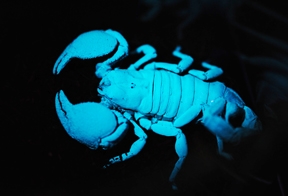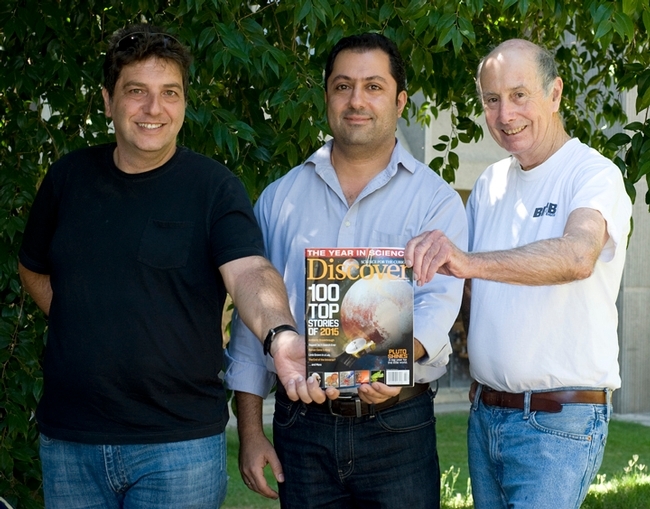
Have you heard about the entomologist who went from researching venomous scorpions to alleviating human neuropathic pain?
That would be Bora Inceoglu, who holds a doctorate in entomology from the University of California, Davis. He and five colleagues were recently informed that their groundbreaking research on neuropathic pain made Discover magazine's Top 100 Science Stories of 2015. In fact, the research ranks among the Top 15 in the Medicine/Genetics category.
The Proceedings of the National Academy of Sciences published the UC Davis research, “Endoplasmic Reticulum Stress in the Peripheral Nervous System is a Significant Driver of Neuropathic Pain,” in July 2015. (See UC Davis news story)
Inceoglu, a researcher in the Bruce Hammock lab, UC Davis Department of Entomology and Nematology/UC Davis Comprehensive Cancer Center, and Ahmed Bettaieb, then of the Fawaz Haj lab, Department of Nutrition, served as the lead researchers. The six-member team, in addition to Inceoglu, Bettaieb, Haj, and Hammock, included K.S. Lee and Carlos Trindade da Silva, both of the Department of Entomology and Nematology/UC Davis Comprehensive Cancer Center.
They pinpointed the key mechanism that causes neuropathic pain--a complex, chronic and difficult-to-treat pain caused by nerve injuries from trauma or from such diseases as diabetes, shingles, multiple sclerosis and stroke.

Discover magazine headlined its story on the UC Davis research: “A Key Piece of the Pain Puzzle Is Solved.” Writer Heather Stringer quoted Hammock as saying: “Medications have historically focused on turning down the nerve response to pain, but now we've found one way to block the stress signal that generates the pain.
“Most of us probably take for granted that physical pain—whether it be from a sports injury, a kidney stone or appendicitis—can be attributed to some form of inflammation and that it will end,” Stringer wrote.
“Neuropathic pain, however, affords its sufferers no such luxuries,” Stringer pointed out. “It's chronic and unrelenting, and its cause is unknown, making treatment difficult. It turns out that neuropathic pain is triggered when the body experiences endoplasmic reticulum (ER) stress, a condition in which the production and transport of protein exceeds the cells' capacities, say researchers from the University of California, Davis. Because diabetics are at high risk of having neuropathic pain, the team studied diabetic rats that had neuropathic symptoms: hypersensitivity to touch and lack of heat sensation. And the rats' nerve cells showed clear signs of ER stress.”
“When the researchers treated the rats with a compound that blocks ER stress, the pain symptoms disappeared. Conversely, healthy rats developed neuropathy when they received chemicals that induce the stress response.”

How It All Began
Hammock discovered a human enzyme termed sEH which regulates a new class of natural chemical mediators. He and his lab then developed inhibitors of the sEH enzyme which degrades natural mediators reducing hypertension, inflammation and pain.
Recently he founded the company, Eicosis LLC, to target diabetic neuropathic pain. The company just received two large federal grants for translational drug development and aims to move one of the sEH inhibitors to human clinical trials.
Hammock, who holds a doctorate in entomology/toxicology from UC Berkeley in 1973, joined the UC Davis entomology faculty in 1980. He is a member of the National Academy of Sciences and a fellow of the National Academy of Inventors. The Hammock lab is the 30-year home of the UC Davis/NIEHS Superfund Research and Training Program, an interdisciplinary program funded by the National Institute of Environmental Sciences (NIEHS) that has brought in almost $60 million to the UC Davis campus. The Hammock lab is also the home of the NIH Training Grant in Biomolecular Technology. The lab alumni, totaling more than 100 graduates, hold positions of distinction in academia, industry and government as well as over 300 postdoctorates.
From Insects to Humans
How did Bora Inceoglu move from entomology to neuropathic pain?
"As most kids I found insect fascinating from the start, little machines that could do so much," he said. "As an undergraduate, I studied plant protection. Half of the curriculum was basic and applied entomology, the other half being plant pathology and weed science. Therefore, my college degree was mostly based on pest management and I found insecticide resistance most interesting. This was the impetus for seeking an advanced degree in this area."
Inceoglu was awarded two separate scholarships to study insecticide resistance in the U.S. His research of prominent laboratories in this area landed him in the Hammock laboratory in 1996. "Bruce was my major professor and I completed my Ph.D. in his laboratory in 2002," Inceoglu said. "My thesis was isolation and characterization of insect selective toxins from the venom of scorpions and Dr. Hammock had just received a sizable sample of venom of a South African scorpion, well known for its highly toxic properties. The insect selective toxins were highly sought after at the time because Dr. Hammock developed the technology to engineer these small peptides into the genome of an insect selective virus, a baculovirus. The genetically modified baculoviruses are much faster in killing the pest insects owing to the toxin being produced as the virus infects the host larvae and replicates within."
"Although unexpected, when I started characterizing the new venom we had, we found no insect selective peptide toxins in it," Inceoglou recalled. "Instead we identified a whole new class of peptides that affect mammalian ion channels." To make his work easier, he tried and obtained the live scorpion specimens imported from South Africa. "I do not think they are available for sale now but at the time I was able to get together a few dozens of these animals. I periodically milked the venom from these scorpions which enabled me to have a consistent supply of venom. "
And today?
"Currently we are not working on scorpion venoms," Inceoglu says, "but the technology developed by Dr. Hammock remains as one of the more innovative approaches to pest control."
Meanwhile, neuropathic pain research emanating from UC Davis continues to be spotlighted, as well it should be. It affects some 100 million Americans alone, but even more worldwide.
- Discover Magazine 100 Top Stories of 2015
- Discover Magazine: Key Piece of the Pain Puzzle Is Solved
- PNAS article
- UC Davis News Story: Groundbreaking Research on Neuropathic Pain
- Faculty 1000 Honor
Attached Images:
